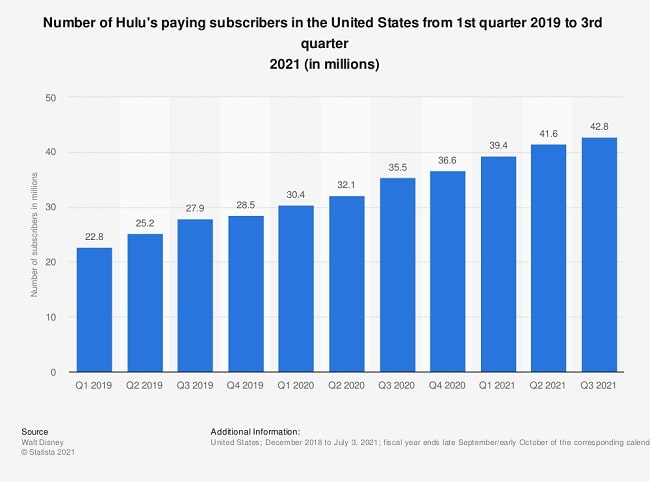Table of Content
While many businesses across industries have struggled due to the pandemic, streaming platforms are among the businesses that have witnessed incredible growth in the number of subscribers.
In fact, the App Annie’s State of Mobile Report 2020 study reveals that Hulu was the leading on-demand video streaming platform in the USA that saw the largest growth in terms of time spent on Android smartphones.
Table of Contents
- ⦁ What is Hulu?
- ⦁ Key Stats and Facts About Hulu
- ⦁ The Success Timeline of Hulu
- ⦁ Hulu Story: The Journey to Become One of the Key Players in the OTT Industry
- ⦁ Hulu’s Customer Segments
- ⦁ Value Propositions Offered by Hulu
- ⦁ The Hulu Business Model Explained
- ⦁ The Hulu Revenue Model Explained
If you’re thinking of building a similar on-demand video streaming platform like Hulu, this post is exclusively for you. Here, we’ll enlighten you on Hulu’s business and revenue model in detail – how the platform works and makes money.
But before getting to that, let’s first have a look at what Hulu is all about and some key facts related to the platform.
What is Hulu?
 Hulu is an on-demand video streaming platform that enables users to stream TV shows and movies online. In fact, it’s one of the largest and popular streaming platforms in the US, with 40+ million subscribers.
Hulu is an on-demand video streaming platform that enables users to stream TV shows and movies online. In fact, it’s one of the largest and popular streaming platforms in the US, with 40+ million subscribers.
What makes Hulu different from its key competitors such as Netflix and Amazon Prime Video is that it represents a great cable-cutting alternative for many traditional cable subscribers.
Not only does Hulu boasts a huge collection of 2,500+ movies and 40,000+ episodes from around 1,650 TV shows, it even enables users to stream live TV via the Hulu + Live TV plan.
Key Stats and Facts About Hulu
- ⦁ Year of Foundation: 2007
- ⦁ Founders: Elizabeth Comstock, Jason Kilar
- ⦁ Headquarters: Los Angeles, California, United States
- ⦁ Area Served: U.S. and Japan
- ⦁ Number of Funding Rounds: 3 (As Per Hulu’s Crunchbase Profile)
- ⦁ Total Funding Amount: $683M
The Success Timeline of Hulu
Here’s a quick look at Hulu’s success timeline:
| 2006 – | Hulu Was Announced |
| 2007 – | www.hulu.com Was Launched |
| 2007 – | Raised $100M in Funding |
| 2010 – | Hulu Launched Subscription Service – Hulu Plus |
| 2016 – | Raised $583M in Funding |
| 2016 – | Hits 12M Subscribers |
| 2017 – | The Only Streaming Platform to Introduce Live TV |
| 2019 – | The Walt Disney Company Fully Acquired Hulu |
| 2021 – | Hits Around 43.8M Subscribers |
Hulu Story: The Journey to Become One of the Key Players in the OTT Industry
Hulu, one of the popular video-on-demand platforms in the USA, was established by NBC Universal executives (Jason Kilar and Beth Comstock) as a joint venture with founding partners – AOL, Facebook, Comcast, MSN, Yahoo, and MySpace.
Hulu started its journeys with an ad-supported business model focused on streaming the TV shows for free with advertisements that interrupted the streaming experience.
In 2010, Hulu came up with its paid subscription service (known as Hulu Plus today) to compete with other key players in the OTT industry such as Netflix.
The paid subscription offered by Hulu wasn’t add-free but provided a more collection in terms of TV shows and devices on which the platform could be accessed.
Hulu collaborated with Yahoo! to migrate its free content to Yahoo! View and become a fully-fledged subscription service.
In 2017, Hulu launched its Live TV service that enables users to live stream 50+ broadcast and cable-originated programming. Subsequently, premium add-ons such as HBO and additional features and benefits such as six account profiles, OTT and more were also introduced.
As a result of these initiatives, Hulu has 42.8M subscribers as of the third quarter of 2021.

Hulu’s Customer Segment
- ⦁ People who yearn for on-demand, quality TV programming
- ⦁ People who like to watch web-connected TV
- ⦁ People interested in the advertising sector (advertisers & agencies)
Value Propositions offered by Hulu
- ⦁ Enable users to enjoy premium TV content on-demand
- ⦁ Provide great convenience & flexibility
- ⦁ Provide users with access to recent content
- ⦁ Enable users to stream original content
- ⦁ Provide advertisers huge audience to market or promote their content
Key Channels (Accessible)
- ⦁ Mobile & desktop website (www.hulu.com)
- ⦁ Mobile apps for Android, iOS & Windows Phone OS
- ⦁ Apps vis Smart TV, set-top boxes, Blu-ray players & gaming consoles
The Hulu Business Model Explained
Hulu currently works on a Subscription Video on Demand (SVOD) model.
To stream content on Hulu, users will have to sign up on the platform. After signing up, Hulu offers a free trial and four different subscription plans to choose from to enjoy the latest movies and TV shows.
Depending on the plan chosen, users can then stream video on demand with/without ads. and video as well as Live TV with/without ads.
As a user, you can stream content on Hulu from various screens and six people can take advantage of a single account with their own profile at a time.
Each profile is unique from the other and doesn’t come at an additional cost; all viewing history and suggestions are even unique to each profile.
The Hulu Revenue Model Explained
The revenue model of Hulu is pretty easy to comprehend. The platform makes money via three sources: subscriptions, add-ons and advertisements.
Let’s discuss all of them in more detail:
-
⦁ Subscription Revenue Model
Hulu charges a subscription fee on a monthly or annual basis to access the platform.
The platform offers four subscription plans to meet the needs of more than one set of customer. Below is a quick overview of Hulu’s subscription plan:
- ⦁ Hulu (With Ads): $6.99/month or $69.99/year
- ⦁ Hulu (No Ads): $12.99/month
- ⦁ Hulu + Live TV (With Ads): $64.99/month
- ⦁ Hulu (No Ads) + Live TV: $70.99/month
Every plan comes with a free trial option. The platform provides unlimited access to its streaming library for 30 days (if users choose Hulu’s standard) or 7 days (if users subscribe to Hulu + Live TV).
Once the trial period ends, the platform charges a month-to-month subscription fee that’s a huge part of Hulu’s revenue stream.
In fact, Hulu generated revenue of approximately $4.4 billion in 2020 and subscription revenue accounted for around $2.9 billion.
-
⦁ Add-Ons Based Revenue Model
Once subscribing to one of Hulu’s plans, the platform provides access to add-ons at an additional cost that contributes to the part of Hulu’s revenue stream.
Hulu provides access to 4 types of subscription add-ons: partner, premium, network, and feature.
Below is the list of add-ons available on the platform:
- ⦁ Partner: ESPN+
- ⦁ Premium: HBO Max, Cinemax, Showtime, Starz
- ⦁ Network: Espanol Add-on, Entertainment Add-on, Sports Add-on
- ⦁ Feature: Unlimited Screens, Enhanced Cloud DVR,
This source of revenue is a great example of a cross-selling and upselling business model.
-
⦁ Advertising Based Revenue Model
Another significant source of Hulu’s revenue is its ad business. In 2018, Hulu generated nearly $1.46 billion in ad revenue and that number is projected to reach $2.7 billion in 2021, as per Statista. This depicts an increase of 32.65% on a yearly basis.
Though Hulu offers ad-free subscription plans, the majority of subscribers on the platform are on the ad-supported plan. Thus, it’s no surprise to witness the advertising revenue of Hulu escalating year after year.
Interested in Building a Streaming Platform Like Hulu?
If you’ve made up your mind to build an on-demand video streaming platform like Hulu, the next important decision is to come up with a budget for product development.
To compete with already existing strong players like Hulu, you need a strong development partner who can help you successfully bring your product idea to life – all while keeping the budget low.
That’s why outsourcing development to a dedicated remote development team has become a common approach among startups and businesses when it comes to end-to-end custom product development.
With remote developers, you don’t just get to work with the industry’s best talent but save on recruitment, infrastructure and training costs. We at InfoStride provide dedicated remote teams to startups and companies with flexible and affordable engagement models.
Hiring remote developers to build a streaming app like Hulu from us can give you the following benefits:
- ⦁ Pre-screened and trained experts- consultants, designers, developers, project managers, scrum masters, business analysts.
- ⦁ End-to-end development support for your project – from initial consultation, designing, development, deployment and maintenance.
- ⦁ Access to state-of-the-art development center and emerging technologies such as AI, Blockchain, AR, Machine learning, Big Data and more.
- ⦁ Full support for administrative and legal aspects – onboarding, payroll, taxes, compliance and offboarding.
Still have questions? Schedule a free consultation session with our experts to clear any doubts you have in mind about hiring remote developers or building a streaming platform app like Hulu.
hbspt.forms.create({
region: “na1”,
portalId: “20184836”,
formId: “c108011c-3782-41c8-afeb-3034f8ff361d”
});
Conclusion
One of the key reasons why Hulu is giving strong competition to other key players in the on-demand video streaming market lies in its business model and own unique content.
When it comes to building a streaming app like Hulu, it’s imperative to get deep into Hulu’s business and revenue model to understand its strategies to grab the market share. Through this post, we’ve covered all significant sources of Hulu’s revenue and how it works.
Just remember that each business is unique. So, you need to give thought when it comes to choosing business and revenue models before starting your own video streaming business. Conducting market research is a way to validate your business idea.





